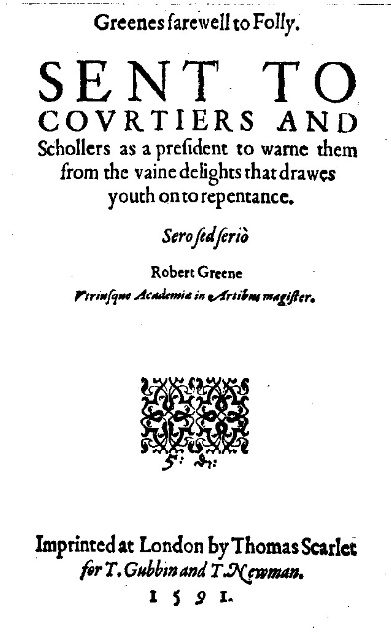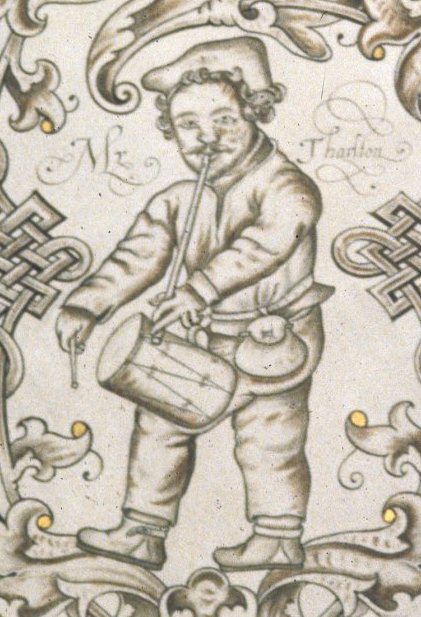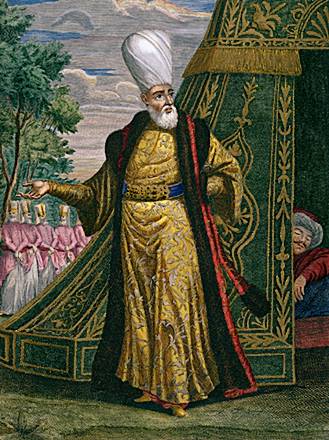|
Selimus (play)
''Selimus'', or ''The Tragedy of Selimus, Sometime Emperor of the Turks'', is a dramatic tragedy generally attributed to the authors Robert Greene and Thomas Lodge. It is an early example of a "Turk play", which became a popular dramatic subject during the English Renaissance. Published in 1594, the play is loosely – and historically inaccurately – based on Selim I, a real Emperor of the Ottoman Empire in the 1500s.Sahiner, Mustafa. “Oriental Matter Revisited: Representations of the “Turk” in Robert Greene’s Selimus.” Journal of Arts and Sciences. December 2008. The play centres on Selimus, who is the youngest son of Bajazet, the current Emperor of Turkey, and how he plans to take the crown away from his father. The play follows the family turmoil that ensues as Selimus, Acomat, and Corcut, all sons of Bajazet, war and murder in an attempt to control the crown. Nearly all of Bajazet's line of descent is eradicated by the end of the play, and Selimus is left to rule ... [...More Info...] [...Related Items...] OR: [Wikipedia] [Google] [Baidu] |
Robert Greene (dramatist)
Robert Greene (1558–1592) was an English author popular in his day, and now best known for a posthumous pamphlet attributed to him, '' Greene's Groats-Worth of Witte, bought with a million of Repentance'', widely believed to contain an attack on William Shakespeare. Greene was a popular Elizabethan dramatist and pamphleteer known for his negative critiques of his colleagues. He is said to have been born in Norwich. He attended Cambridge where he received a BA in 1580, and an M.A. in 1583 before moving to London, where he arguably became the first professional author in England. He was prolific and published in many genres including romances, plays and autobiography. Family According to the author Brenda Richardson, the "chief problem" in compiling a biography of Robert Greene was his name. ''Robert'' was one of the most popular given names of the era and ''Greene'' was a common surname. L. H. Newcomb suggests that Robert Greene "was probably the Robert Greene, son of Robert ... [...More Info...] [...Related Items...] OR: [Wikipedia] [Google] [Baidu] |
Thomas Lodge
Thomas Lodge (September 1625) was an English writer and medical practitioner whose life spanned the Elizabethan and Jacobean periods. Biography Early life Thomas Lodge was born about 1557 in West Ham, the second son of Sir Thomas Lodge, Lord Mayor of London, by his third wife Anne (1528–1579), daughter of Henry Luddington (died 1531), a London grocer. The year before he was born his father had transferred the ownership the manors of Hawkstone and Soulton to Sir Rowland Hill, publisher of the Geneva Bible and a fellow Lord Mayor. The Lodge family continued some form of association with those manors, and it has been suggested that this was part of the inspiration of Lodge junior's literary output. He was educated at Merchant Taylors' School and Trinity College, Oxford; taking his BA in 1577 and MA in 1581. In 1578 he entered Lincoln's Inn, where, as in the other Inns of Court, a love of letters and a crop of debts were common. Early literary work Lodge, dis ... [...More Info...] [...Related Items...] OR: [Wikipedia] [Google] [Baidu] |
English Renaissance
The English Renaissance was a Cultural movement, cultural and Art movement, artistic movement in England during the late 15th, 16th and early 17th centuries. It is associated with the pan-European Renaissance that is usually regarded as beginning in Italy in the late 14th century. As in most of the rest of Northern Europe, England saw little of these developments until more than a century later within the Northern Renaissance. Renaissance style and ideas were slow to penetrate England, and the Elizabethan era in the second half of the 16th century is usually regarded as the height of the English Renaissance. Many scholars see its beginnings in the early 16th century during the reign of Henry VIII. Others argue the Renaissance was already present in England in the late 15th century. The English Renaissance is different from the Italian Renaissance in several ways. The dominant art forms of the English Renaissance were literature and music. Visual arts in the English Renaissance w ... [...More Info...] [...Related Items...] OR: [Wikipedia] [Google] [Baidu] |
Selim I
Selim I (; ; 10 October 1470 – 22 September 1520), known as Selim the Grim or Selim the Resolute (), was the List of sultans of the Ottoman Empire, sultan of the Ottoman Empire from 1512 to 1520. Despite lasting only eight years, his reign is notable for the enormous expansion of the Empire, particularly his Ottoman–Mamluk War (1516–1517), conquest between 1516 and 1517 of the entire Mamluk Sultanate of Egypt, which included all of the Levant, Hejaz, Tihamah and Egypt itself. On the eve of his death in 1520, the Ottoman Empire spanned about , having grown by seventy percent during Selim's reign. Selim's conquest of the Middle Eastern heartlands of the Muslim world, and particularly his assumption of the role of guardian of the Hajj, pilgrimage routes to Mecca and Medina, established the Ottoman Empire as the pre-eminent Muslim state. His conquests dramatically shifted the empire's geographical and cultural center of gravity away from the Balkans and toward the Middle East ... [...More Info...] [...Related Items...] OR: [Wikipedia] [Google] [Baidu] |
Ottoman Empire
The Ottoman Empire (), also called the Turkish Empire, was an empire, imperial realm that controlled much of Southeast Europe, West Asia, and North Africa from the 14th to early 20th centuries; it also controlled parts of southeastern Central Europe, between the early 16th and early 18th centuries. The empire emerged from a Anatolian beyliks, ''beylik'', or principality, founded in northwestern Anatolia in by the Turkoman (ethnonym), Turkoman tribal leader Osman I. His successors Ottoman wars in Europe, conquered much of Anatolia and expanded into the Balkans by the mid-14th century, transforming their petty kingdom into a transcontinental empire. The Ottomans ended the Byzantine Empire with the Fall of Constantinople, conquest of Constantinople in 1453 by Mehmed II. With its capital at History of Istanbul#Ottoman Empire, Constantinople (modern-day Istanbul) and control over a significant portion of the Mediterranean Basin, the Ottoman Empire was at the centre of interacti ... [...More Info...] [...Related Items...] OR: [Wikipedia] [Google] [Baidu] |
Queen Elizabeth's Men
Queen Elizabeth's Men was a playing company or troupe of actors in English Renaissance theatre. Formed in 1583 at the express command of Queen Elizabeth, it was the dominant acting company for the rest of the 1580s, as the Admiral's Men and the Lord Chamberlain's Men would be in the decade that followed. Foundation Since the Queen instigated the formation of the company, its inauguration is well documented by Elizabethan standards. The order came down on 10 March 1583 (new style) to Edmund Tilney, then the Master of the Revels; though Sir Francis Walsingham, head of intelligence operations for the Elizabethan court, was the official assigned to assemble the personnel. At that time the Earl of Sussex, who had been the court official in charge of the Lord Chamberlain's Men in its first Elizabethan incorporation, was nearing death. The Queen's Men assumed the same functional role in the Elizabethan theatrical landscape as the Lord Chamberlain's Men before and after them did: ... [...More Info...] [...Related Items...] OR: [Wikipedia] [Google] [Baidu] |
Thomas Goffe
Thomas Goffe (1591–1629) was a minor Jacobean dramatist. Life Thomas Goffe was born in Essex in 1591. He first studied at Westminster School where he had the status of a Queen's Scholar. Goffe received a scholarship on 3 November 1609 to attend Christ Church, Oxford. Here he received his bachelor of arts (B.A.) on 17 June 1613 and continued to get his master of arts (M.A.), on 20 June 1616. While involved with acting and writing plays at Christ Church, Goffe continued school. On 3 July 1623, he acquired his bachelor of divinity and became licensed to preach shortly after on 11 July 1623."Goffe or Gough, Thomas." ''Oxford Dictionary of National Biography'' 8 (1917): 70–71. Goffe was asked to be a rector of the church in East Clandon, Surrey after receiving his B.D., an offer worth about eight pounds a year.(1) However, Goffe began delivering Latin orations and writing poems in tribute to Sir Thomas Bodley and Queen Anne of Denmark as well as to the dean of Christ Church, W ... [...More Info...] [...Related Items...] OR: [Wikipedia] [Google] [Baidu] |
Alexander Balloch Grosart
Alexander Balloch Grosart (18 June 182716 March 1899) was a Scottish clergyman and literary editor. He is chiefly remembered for reprinting much rare Elizabethan literature, a work which he undertook because of his interest in Puritan theology. Life The son of a building contractor, he was born at Stirling and educated at the University of Edinburgh. In 1856 he became a minister of the United Presbyterian Church of Scotland at Kinross, serving the congregation known as First United Presbyterian Church. In 1865 he went to Liverpool, and three years later to Blackburn. He resigned from the ministry in 1892, and died at Dublin. Editorial work Among the first writers whose works he edited were the Puritan writers, Richard Sibbes, Thomas Brooks and Herbert Palmer. Editions of Michael Bruce's ''Poems'' (1865) and Richard Gilpin's ''Demonologia sacra'' (1867) followed. In 1868 he brought out a bibliography of the writings of Richard Baxter, and from that year until 1876 he was ... [...More Info...] [...Related Items...] OR: [Wikipedia] [Google] [Baidu] |
Janissaries
A janissary (, , ) was a member of the elite infantry units that formed the Ottoman sultan's household troops. They were the first modern standing army, and perhaps the first infantry force in the world to be equipped with firearms, adopted during the reign of Murad II (r. 1421–1444, 1446–1451). The corps was established under either Orhan or Murad I, and dismantled by Mahmud II in 1826. Janissaries began as elite corps made up through the '' devşirme'' system of child levy enslavement, by which indigenous European Christian boys, chiefly from the Balkans, were taken, levied, subjected to forced circumcision and forced conversion to Islam, and incorporated into the Ottoman army. They became famed for internal cohesion cemented by strict discipline and order. Unlike typical slaves, they were paid regular salaries. Forbidden to marry before the age of 40 or engage in trade, their complete loyalty to the Ottoman sultan was expected. By the 17th century, due to a drama ... [...More Info...] [...Related Items...] OR: [Wikipedia] [Google] [Baidu] |
Smederevo
Smederevo ( sr-Cyrl, Смедерево, ) is a list of cities in Serbia, city and the administrative center of the Podunavlje District in eastern Serbia. It is situated on the right bank of the Danube, about downstream of the Serbian capital, Belgrade. According to the 2022 census, the city has a population of 59,261, with 97,930 people living in its administrative area. Its history starts in the 1st century BC, after the conquest of the Roman Empire, when there existed a settlement by the name of Vinceia. The modern city traces its roots back to the Late Middle Ages when it was the capital (1430–39, and 1444–59) of the last Serbian Despotate, independent Serbian state before Ottoman Empire, Ottoman conquest. Smederevo is said to be the city of iron ( sr-Cyrl-Latn, гвожђе, gvožđe, separator=" / ", label=none) and grapes ( sr-Cyrl-Latn, грожђе, grožđe, separator=" / ", label=none). Names In Serbian language, Serbian, the city is known as ''Smederevo'' ... [...More Info...] [...Related Items...] OR: [Wikipedia] [Google] [Baidu] |
Byzantium
Byzantium () or Byzantion () was an ancient Greek city in classical antiquity that became known as Constantinople in late antiquity and Istanbul today. The Greek name ''Byzantion'' and its Latinization ''Byzantium'' continued to be used as a name of Constantinople sporadically and to varying degrees during the thousand-year existence of the Eastern Roman Empire, which also became known by the former name of the city as the Byzantine Empire. Byzantium was colonized by Greeks from Megara in the 7th century BCE and remained primarily Greek-speaking until its conquest by the Ottoman Empire in 1453 CE. Etymology The etymology of ''Byzantium'' is unknown. It has been suggested that the name is of Thracian origin. It may be derived from the Thracian personal name Byzas which means "he-goat". Ancient Greek legend refers to the Greek king Byzas, the leader of the Megarian colonists and founder of the city. The name '' Lygos'' for the city, which likely corresponds to an earlier T ... [...More Info...] [...Related Items...] OR: [Wikipedia] [Google] [Baidu] |
Janissaries
A janissary (, , ) was a member of the elite infantry units that formed the Ottoman sultan's household troops. They were the first modern standing army, and perhaps the first infantry force in the world to be equipped with firearms, adopted during the reign of Murad II (r. 1421–1444, 1446–1451). The corps was established under either Orhan or Murad I, and dismantled by Mahmud II in 1826. Janissaries began as elite corps made up through the '' devşirme'' system of child levy enslavement, by which indigenous European Christian boys, chiefly from the Balkans, were taken, levied, subjected to forced circumcision and forced conversion to Islam, and incorporated into the Ottoman army. They became famed for internal cohesion cemented by strict discipline and order. Unlike typical slaves, they were paid regular salaries. Forbidden to marry before the age of 40 or engage in trade, their complete loyalty to the Ottoman sultan was expected. By the 17th century, due to a drama ... [...More Info...] [...Related Items...] OR: [Wikipedia] [Google] [Baidu] |







